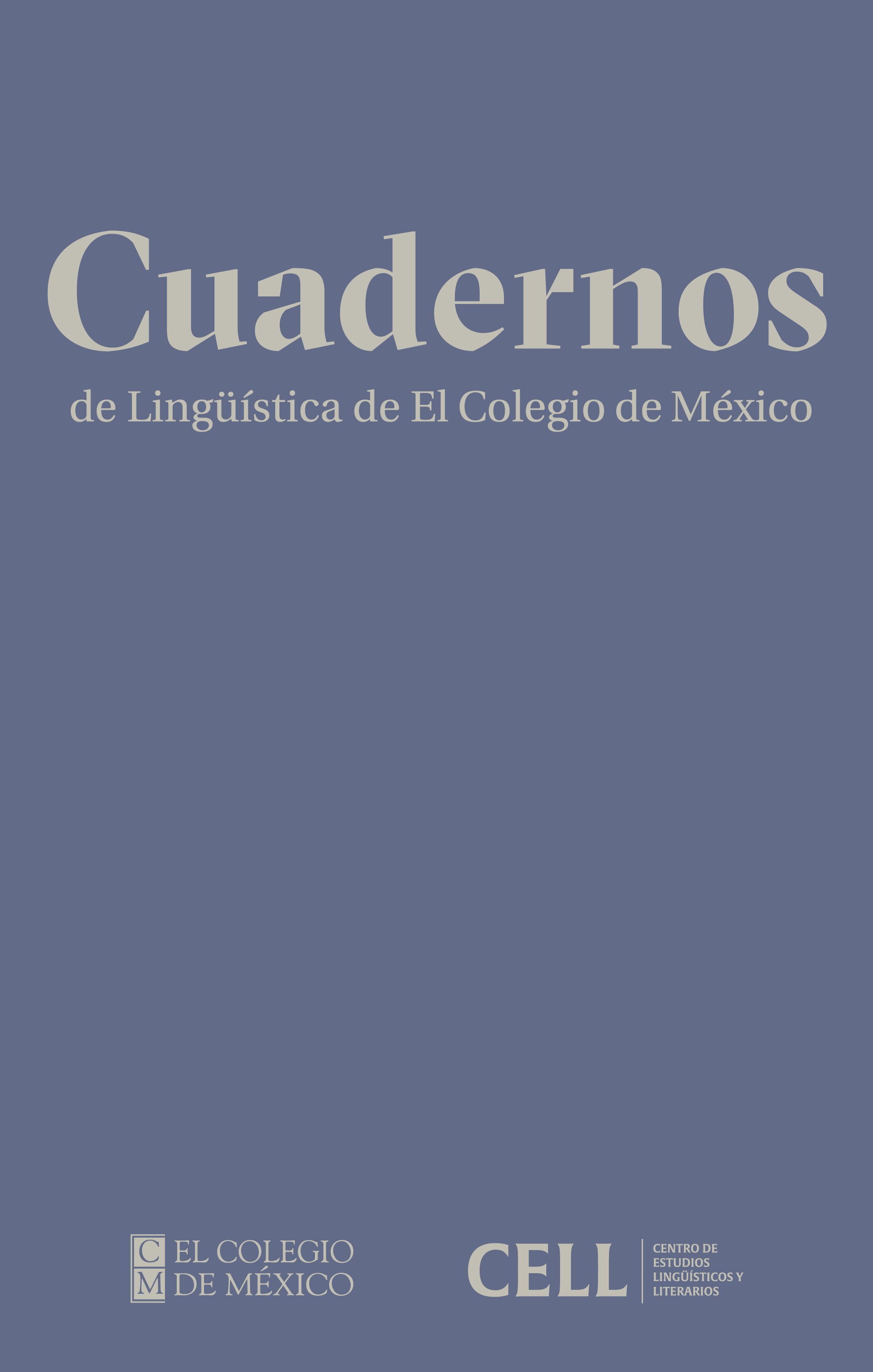Reseña a Francis, Elaine J. 2022. Gradient acceptability and linguistic theory. Oxford University Press, 267 pp.
DOI:
https://doi.org/10.24201/clecm.v9i0.256Palabras clave:
Conocimiento del lenguaje, Sintaxis, Semántica, Juicios de aceptabilidadDescargas
Citas
Agulló, Jorge. 2022. Las oraciones de relativo predicativas en español: pronombres reasuntivos y variación dialectal. Zeitschrift für romanische Philologie 138(1). 161–191. https://doi.org/10.1515/zrp-2022-0005 DOI: https://doi.org/10.1515/zrp-2022-0005
Ambridge, Ben. 2013. How do children restrict their linguistic generalizations? An (un)grammaticality judgment study. Cognitive Science 37(3). 508–43. DOI: https://doi.org/10.1111/cogs.12018
Antal, Caitlyn & de Almeida, Roberto. 2021. Indetermined and enriched propositions in context linger: Evidence from aneye-tracking false memory paradigm. Frontiers in Psychology 12. https://doi.org/10.3389/fpsyg.2021.741685 DOI: https://doi.org/10.3389/fpsyg.2021.741685
Bresnan, Joan. 2000. Lexical-functional syntax. Malden, MA: Blackwell.
Bybee, Joan L. & Hopper, Paul J. 2001. Frequency and the emergence of linguistic structure. Ámsterdam: John Benjamins. DOI: https://doi.org/10.1075/tsl.45
Chomsky, Noam. 1981. Lectures on government and binding. Dordrecht: Foris.
Chomsky, Noam. 1995. The minimalist program. Cambridge, MA: MIT Press.
Christianson, Kiel; Hollingworth, Andrew; Halliwell, John F. & Ferreira, Fernanda. 2001. Thematic roles assigned along the garden path linger. Cognitive Psychology 42. 368–407. doi: https://doi.org/10.1006/cogp.2001.0752 DOI: https://doi.org/10.1006/cogp.2001.0752
Culicover, Peter W. & Jackendoff, Ray S. 2005. Simpler syntax. Oxford: Oxford University Press. DOI: https://doi.org/10.1093/acprof:oso/9780199271092.001.0001
Divjak, Dagmar. 2017. The role of lexical frequency in the acceptability of syntactic variants: Evidence from That-Clauses in Polish. Cognitive Science 41 (2). 354–382. DOI: https://doi.org/10.1111/cogs.12335
Fernández Soriano, Olga. 1995. Pronombres reasuntivos y doblado de clíticos. En Goenaga Mendizaval P. (ed.) De grammatica generativa, 109–130. San Sebastián: Universidad del País Vasco.
Ferreira, Fernanda; Bailey, Karl & Ferraro, Vittoria. 2002. Goodenough representations in language comprehension. Current Directions in Psychological Science 11(1). 11–15. DOI: https://doi.org/10.1111/1467-8721.00158
Frank, Stefan & Christiansen, Morten. 2018. Hierarchical and sequential processing of language. Language, Cognition and Neuroscience 33. https://doi.org/10.1080/23273798.2018.1424347. DOI: https://doi.org/10.1080/23273798.2018.1424347
Givón, Thomas. 1984. Syntax: A functional-typological approach. Ámsterdam: John Benjamins. DOI: https://doi.org/10.1075/z.17
Givón, Thomas. 1985. Iconicity, isomorphism, and non-arbitrary coding in syntax. En Haiman J. (ed.). Iconicity in syntax, 187–220. Ámsterdam: John Benjamins. DOI: https://doi.org/10.1075/tsl.6.10giv
Grimshaw, Jane. 1997. Projection, heads, and optimality. Linguistic Inquiry 28(3). 373–422.
Jackendoff, Ray. 2010. Fundamentos del lenguaje. Mente, significado, gramática y evolución. México: Fondo de Cultura Económica.
Karimi, Hossain & Ferreira, Fernanda. 2016. Good-enough linguistic representations and online cognitive equilibrium in language processing. Quarterly journal of experimental psychology 69(5).1013–1040. DOI: https://doi.org/10.1080/17470218.2015.1053951
Koornneef, Arnout & Reuland, Eric. 2016. On the shallow processing (dis)advantage: Grammar and economy. Frontiers in Psychology 7. https://www.frontiersin.org/articles/10.3389/fpsyg.2016.00082/full DOI: https://doi.org/10.3389/fpsyg.2016.00082
Laca, Brenda. 2006. Pluralidad y aspecto verbal en español. Revista Española de Lingüística 36. 7–41.
Langacker, Ronald W. 1987. Foundations of cognitive grammar: Theoretical prerequisites. Stanford, CA: Stanford University Press.
Levy, Roger. 2008. Expectation-based syntactic comprehension. Cognition 106(3). 1126-1177. https://doi.org/10.1016/j.cognition.2007.05.006 DOI: https://doi.org/10.1016/j.cognition.2007.05.006
Lopes Camara, Aliana. 2018. El procesamiento de la oración relativa en español: interferencias del factor “distancia” en el uso del pronombre reasuntivo. Forma y Función 31(2). 69–92. DOI: https://doi.org/10.15446/fyf.v31n2.74657
McCarthy, John J. & Prince, Alan. 1995. Faithfulness and reduplicative identity. Linguistics Department Faculty Publication Series 106(3). 1126–1177.
Pickering, Martin J. & Ferreira, Victor S. 2008. Structural priming: a critical review. Psychological bulletin 134(3). 427–459. https://doi.org/10.1037/0033-2909.134.3.427 DOI: https://doi.org/10.1037/0033-2909.134.3.427
Poeppel, David & Embick, David. 2013. Defining the relation between linguistics and neuroscience. En Cutler A. (ed.) Twenty-first century psycholinguistics. Four cornerstones, 103–120. Lawrence Erlbaum.
Suárez Fernández, Mercedes. 2013. Funcionalidad del pronombre reasuntivo en cláusulas relativas en español. Moenia 19. 63–96.
Trebisacce, Romina V. 2019. La incidencia de la sintaxis y de la estructura argumental en la interpretación télica de los eventos. Universidad de Buenos Aires. (Tesis doctoral).
Van Gompel, Roger; Pickering, Martin; Pearson, Jamie & Jacob, Gunnar. 2006. The activation of inappropriate analyses in garden-path sentences: Evidence from structural priming. Journal of Memory and Language 55. 335–362. DOI: https://doi.org/10.1016/j.jml.2006.06.004
Publicado
Cómo citar
-
Resumen569
-
PDF117
-
XML4
-
EPUB46
-
Kindle57
-
MP311
Número
Sección
Licencia
Derechos de autor 2022 Gabriela Mariel Zunino

Esta obra está bajo una licencia internacional Creative Commons Atribución-NoComercial-SinDerivadas 4.0.
Los autores conservan los derechos sobre su obra y tienen libertad de diseminar su trabajo y hacerlo disponible en otros lugares (repositorios, páginas web personales, antologías), pero garantizarán a esta revista el derecho de primera publicación y se comprometen a citar CLECM como referencia de la publicación original.
Los trabajos publicados en Cuadernos de Lingüística de El Colegio de México se publican bajo los términos que se indican en la Licencia Creative Commons con Atribución-NoComercial-SinDerivadas 4.0 Internacional.








